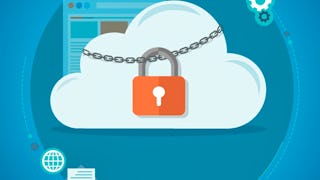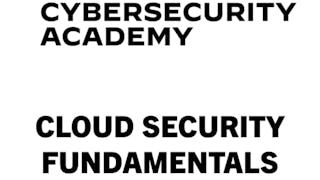In this course, you will learn how to secure cloud environments using industry-standard platforms like AWS, Azure, and GCP. You'll explore essential security concepts and strategies to ensure that your cloud infrastructure remains safe from evolving threats.



Cloud Security Essentials: AWS, Azure, GCP Protection

Instructor: Packt - Course Instructors
Access provided by Khalifa University
Recommended experience
What you'll learn
Learn to protect compute, storage, and networking services across AWS, Azure, and GCP
Implement IAM policies and best practices to control user access securely in cloud environments
Master encryption techniques to ensure data privacy and security across cloud platforms
Understand and apply cloud security compliance frameworks, ensuring your cloud infrastructure meets industry standards
Skills you'll gain
- Data Security
- Zero Trust Network Access
- Multi-Cloud
- Identity and Access Management
- Virtual Private Networks (VPN)
- Azure Active Directory
- DevSecOps
- Infrastructure Security
- IT Security Architecture
- Threat Management
- Cloud Infrastructure
- Amazon S3
- Data Encryption Standard
- Cloud Security
- Cloud Platforms
- Google Cloud Platform
- Cloud Computing
- AWS Identity and Access Management (IAM)
- Encryption
- Network Security
Details to know

Add to your LinkedIn profile
17 assignments
November 2025
See how employees at top companies are mastering in-demand skills

There are 17 modules in this course
In this section, we explore cloud security best practices across AWS, Azure, and GCP, emphasizing secure environment design and the shared responsibility model. We cover practical applications of command-line tools like AWS CLI, Azure CLI, and Google Cloud SDK to implement security frameworks effectively.
What's included
2 videos3 readings1 assignment
In this section, we explore securing virtual machines across major cloud platforms, focusing on best practices for authentication, network access, patch management, and backups. Key concepts include implementing secure login methods using SDKs, analyzing network access controls, and applying platform-specific security strategies for AWS EC2, Azure VMs, and GCE.
What's included
1 video3 readings1 assignment
In this section, we explore best practices for securing Kubernetes and containerized workloads, focusing on identity and access management, network policies, and auditing strategies. The content emphasizes practical implementation of security measures across cloud platforms like Amazon EKS, AKS, and GKE, ensuring robust protection for modern cloud-native applications.
What's included
1 video7 readings1 assignment
In this section, we explore secure deployment and management of serverless computing and function as a service (FaaS) across AWS, Azure, and GCP. We focus on IAM policies, data protection strategies, and auditing tools to ensure compliance and security in cloud-based functions.
What's included
1 video4 readings1 assignment
In this section, we explore securing cloud storage services including object, block, file, and Container Storage Interface (CSI) storage. Key concepts include implementing secure object storage solutions using S3, Blob Storage, and GCS, designing block storage security with Amazon EBS, Azure Disks, and GPD, and analyzing file storage best practices for EFS, FSx, and Filestore. The section emphasizes practical strategies for protecting sensitive data through IAM, data protection, and auditing techniques across major cloud platforms.
What's included
1 video7 readings1 assignment
In this section, we explore securing virtual networking using AWS VPC, Azure VNet, and Google Cloud VPC, along with best practices for monitoring and configuring network ACLs and security groups. We also cover DNS security, including mitigating DNS spoofing and DDoS attacks, and securing DNS services like Route 53 and Azure DNS. The section addresses securing VPN services across major cloud providers and introduces Zero Trust frameworks such as AWS Verified Access and BeyondCorp, emphasizing secure access control and client-side components.
What's included
1 video8 readings1 assignment
In this section, we explore securing web applications using DDoS protection services like AWS Shield and Azure DDoS Protection, alongside WAF services such as AWS WAF and Google Cloud Armor. We analyze strategies for mitigating network-layer and application-layer attacks, emphasizing practical implementation and best practices for cloud-based security solutions.
What's included
1 video4 readings1 assignment
In this section, we explore securing generative AI (GenAI) workloads using cloud platforms like AWS, Azure, and GCP, focusing on identity and access management (IAM), data protection, and auditing. We examine best practices for deploying GenAI services, including Amazon Bedrock, Azure OpenAI, and Google Vertex AI, to ensure compliance, reduce risks, and maintain ethical standards in AI applications.
What's included
1 video4 readings1 assignment
In this section, we explore IAM strategies for cloud environments, focusing on securing directory services with SAML and OAuth, and evaluating IAM policies in GCP and AWS. The content emphasizes practical applications of identity management, including role-based access control and best practices for securing cloud-based IAM services across platforms like AWS, Microsoft Entra ID, and GCP.
What's included
1 video3 readings1 assignment
In this section, we explore the implementation of audit trails using AWS CloudTrail, Azure Monitor, and Google Cloud Audit Logs to track and analyze cloud activity. We also examine threat detection and response strategies with tools like Amazon GuardDuty, Microsoft Defender for Cloud, and Google Security Command Center, alongside managing cloud-native SIEM solutions such as Microsoft Sentinel and Google Security Operations to enhance security and compliance in cloud environments.
What's included
1 video6 readings1 assignment
In this section, we explore encryption techniques for cloud security, focusing on symmetric and asymmetric encryption, key management services (KMSs), and secure data transmission. We cover practical implementations such as AES 256, AWS KMS, Azure Key Vault, TLS 1.3, and IPSec, emphasizing best practices for encryption in transit, at rest, and in use. The content highlights the importance of securing sensitive data, reducing breach risks, and leveraging cloud-native encryption tools for compliance and confidentiality.
What's included
1 video5 readings1 assignment
In this section, we explore strategies for detecting and mitigating common cloud security threats, including data breaches, misconfigurations, and insecure APIs. Key concepts include IAM best practices, secure key management, and the use of frameworks like MITRE ATT&CK to enhance cloud security posture.
What's included
1 video8 readings1 assignment
In this section, we explore evaluating cloud service providers through risk assessments, contracts, and audits to ensure security and compliance. Key concepts include using SOC 2 Type 2 reports for control evaluation, designing SLAs for incident response, and conducting annual penetration testing for cloud systems.
What's included
1 video4 readings1 assignment
In this section, we explore hybrid cloud strategies, focusing on integrating on-premises and cloud environments using tools like Azure Front Door, site-to-site VPN, and SQL databases. We emphasize identity management with Microsoft Entra Domain Services and discuss secure network architectures, including AWS and Azure connectivity options. The section highlights best practices for centralized identity control, auditing, and securing hybrid environments with AWS IAM, Azure AD, and GCP solutions. It also covers practical applications in storage, computing, and disaster recovery, ensuring consistent operations and security across hybrid infrastructures.
What's included
1 video8 readings1 assignment
In this section, we explore strategies for managing multi-cloud environments using AWS, Azure, and GCP, focusing on cost, security, and compliance. Key concepts include data replication, identity management, encryption in transit and at rest, and cost implications across cloud service providers (CSPs).
What's included
1 video7 readings1 assignment
In this section, we explore the cultural and technical aspects of integrating security into DevOps workflows through DevSecOps. We examine best practices for people, processes, and technology, including secure CI/CD pipeline implementation and cloud-based security tools like Amazon Inspector and GitHub Copilot.
What's included
1 video3 readings1 assignment
In this section, we explore managing security and governance across multi-cloud environments using tools like AWS SCPs, Azure Policy, and Terraform. We focus on automation through infrastructure as code (IaC) and policy as code (PaC) to ensure consistency, compliance, and scalability in large-scale cloud operations.
What's included
1 video5 readings1 assignment
Instructor

Offered by
Why people choose Coursera for their career




Explore more from Information Technology

Edureka

Illinois Tech

Illinois Tech

Palo Alto Networks

